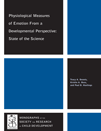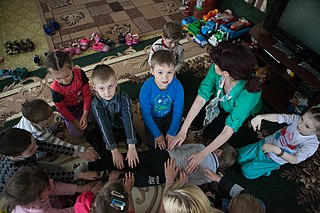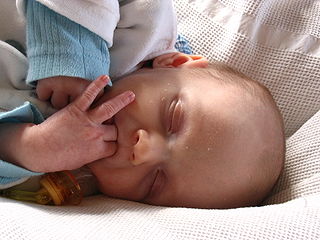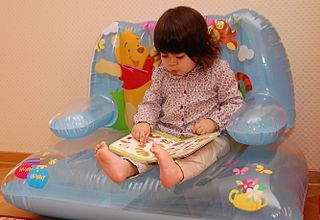 W
WChild development involves the biological, psychological and emotional changes that occur in human beings between birth and the conclusion of adolescence. The main 3 stages of life include early childhood, middle childhood, and adolescence. Early childhood typically ranges from infancy to the age of 6 years old. During this period, development is significant, as many of life's milestones happen during this time period such as first words, learning to crawl, and learning to walk. There is speculation that middle childhood, or ages 6-12 are the most crucial years of a child's life, ranging from the starts of some sorts of formal schooling to the beginning of puberty, and this is also the period where many children start to gain a more sense of self. Adolescence, is the stage of life that typically starts around the time puberty hits, all the way up until legal adulthood. In the course of development, the individual human progresses from dependency to increasing autonomy. It is a continuous process with a predictable sequence, yet has a unique course for every child. It does not progress at the same rate and each stage is affected by the preceding developmental experiences. Because genetic factors and events during prenatal life may strongly influence developmental changes, genetics and prenatal development usually form a part of the study of child development. Related terms include developmental psychology, referring to development throughout the lifespan, and pediatrics, the branch of medicine relating to the care of children.
 W
WBabbling is a stage in child development and a state in language acquisition during which an infant appears to be experimenting with uttering articulate sounds, but does not yet produce any recognizable words. Babbling begins shortly after birth and progresses through several stages as the infant's repertoire of sounds expands and vocalizations become more speech-like. Infants typically begin to produce recognizable words when they are around 12 months of age, though babbling may continue for some time afterward.
 W
WA baby walker is a device that can be used by infants who cannot walk on their own to move from one place to another. Modern baby walkers are also for toddlers. They have a base made of hard plastic sitting on top of wheels and a suspended fabric seat with two leg holes. In the US, baby walkers are responsible for about 2000 injuries annually to children serious enough to require a trip to the emergency room, prompting calls from pediatricians for their outright ban.
 W
WChild development in India is the Indian experience of biological, psychological, and emotional changes which children experience as they grow into adults. Child development has a major influence on personal health and at a national level the health of people in India.
 W
WChildhood studies or children's studies (CS) is a multi-disciplinary field that utilizes all areas of study to understand childhoods as experienced by children historically or contemporary. CS addresses that childhood is "a complex social phenomenon." Additionally, it studies the relationship of children's agency, participating as social actors. Children's studies acknowledge that childhood is socially constructed, as there is no such thing of what childhood means and is not universal. CS draws on scholarship in the social sciences, the humanities, and the behavioral sciences.
 W
WConservation refers to a logical thinking ability that allows a person to determine that a certain quantity will remain the same despite adjustment of the container, shape, or apparent size, according to the psychologist Jean Piaget. His theory posits that this ability is not present in children during the preoperational stage of their development at ages 2–7 but develops in the concrete operational stage from ages 7–11.
 W
WConsumer socialization is the process by which young people acquire skills, knowledge and attitudes relevant to their functioning as consumers in the marketplace. It has been argued, however, that consumer socialization occurs in the adult years as well. This field of study is a subdivision of consumer behaviour as its main focus is on how childhood and adolescent experiences affect future consumer behavior. It attempts to understand how factors such as peers, mass media, family, gender, race, and culture plays an influence in developing customer behavior.
 W
WKazimierz Dąbrowski was a Polish psychologist, psychiatrist, and physician. He is best known for his theory of "Positive disintegration", as a stage in personality development. He was also a poet and used the pen name of "Paul Cienin/Paweł Cienin".
 W
WJosette Frank was an American children's literature expert and educational consultant. Frank spent most of her adult life working for the Child Study Association of America (CSAA), a leading authority on child development from the 1920s to the 1960s. Frank was engaged as the CSAA's child reading expert and published a parental literary guide titled What Books For Children? in 1937 with a new edition in 1941. Due to her progressive views about parental supervision of children's reading, Frank became one of the significant pro-comics voices during the American anti-comics movement of the 1950s, for which she received praise and criticism.
 W
WA grasp is an act of taking, holding or seizing firmly with the hand. An example of a grasp is the handshake, wherein two people grasp one of each other's like hands.
 W
WHyperkinesia refers to an increase in muscular activity that can result in excessive abnormal movements, excessive normal movements or a combination of both. Hyperkinesia is a state of excessive restlessness which is featured in a large variety of disorders that affect the ability to control motor movement, such as Huntington's disease. It is the opposite of hypokinesia, which refers to decreased bodily movement, as commonly manifested in Parkinson's disease.
 W
WThe immigrant paradox is that recent immigrants often outperform more established immigrants and non-immigrants on a number of health-, education-, and conduct- or crime-related outcomes, despite the numerous barriers they face to successful social integration.
 W
WJoint attention or shared attention is the shared focus of two individuals on an object. It is achieved when one individual alerts another to an object by means of eye-gazing, pointing or other verbal or non-verbal indications. An individual gazes at another individual, points to an object and then returns their gaze to the individual. Scaife and Bruner were the first researchers to present a cross-sectional description of children's ability to follow eye gaze in 1975. They found that most eight- to ten-month-old children followed a line of regard, and that all 11- to 14-month-old children did so. This early research showed it was possible for an adult to bring certain objects in the environment to an infant's attention using eye gaze.
 W
WThe Kewpie doll effect is a term used in developmental psychology derived from research in ethology to help explain how a child's physical features, such as lengthened forehead and rounded face, motivate the infant's caregiver to take care of them. The child's physical features are said to resemble a Kewpie doll.
 W
WMelanie Klein was an Austrian-British author and psychoanalyst known for her work in child analysis. She was the primary figure in the development of object relations theory. Klein suggested that pre-verbal existential anxiety in infancy catalyzed the formation of the unconscious, resulting in the unconscious splitting of the world into good and bad idealizations. In her theory, how the child resolves that split depends on the constitution of the child and the character of nurturing the child experiences; the quality of resolution can inform the presence, absence, and/or type of distresses a person experiences later in life.
 W
WThe Mental and Social Life of Babies is a 1982 book by Kenneth Kaye. Integrating a contemporary burgeoning field of research on infant cognitive and social development in the first two years of life with his own laboratory's studies at the University of Chicago, Kaye offered an "apprenticeship" theory. Seen as an empirical turning point in the investigation of processes in early human development, the book's reviews welcomed its reliance on close process studies of a large sample of infants and mothers (50) recorded longitudinally. It was republished in England, Japan, Spain, Italy, and Argentina.
 W
WThe Monographs of the Society for Research in Child Development is a peer-reviewed academic journal published quarterly by Wiley-Blackwell. It is one of three journals published on behalf of the Society for Research in Child Development. The editor-in-chief is Lynn S. Liben. Each issue of Monographs contains a report on one single large-scale study or a group of papers on a common theme, often supplemented with an outside commentary.
 W
WParallel play is a form of play in which children play adjacent to each other, but do not try to influence one another's behavior. Children usually play alone during parallel play but are interested in what other children are doing. This usually occurs after the first birthday. It usually involves two or more children in the same room who are interested in the same toy, each seeing the toy as their own. The children do not play together, but alongside each other simply because they are in the same room. Parallel play is usually first observed in children aged 2–3. An observer will notice that the children occasionally see what the others are doing and then modify their play accordingly. The older the children are, the less frequently they engage in this type of play. However, even older preschool children engage in parallel play, an enduring and frequent activity over the preschool years. The image of parallel play is two children playing side by side in a sandbox, each absorbed in his or her game, not interacting with the other. "This is considered an early stage in child development, characterized by egocentric behavior and the inability to decenter and coordinate with the activities of a 'playmate'".
 W
WJean Piaget was a Swiss psychologist known for his work on child development. Piaget's theory of cognitive development and epistemological view are together called "genetic epistemology".
 W
WPiaget's theory of cognitive development is a comprehensive theory about the nature and development of human intelligence. It was originated by the Swiss developmental psychologist Jean Piaget (1896–1980). The theory deals with the nature of knowledge itself and how humans gradually come to acquire, construct, and use it. Piaget's theory is mainly known as a developmental stage theory. Piaget "was intrigued by the fact that children of different ages made different kinds of mistakes while solving problems". He also believed that children are not like "little adults" who may know less; children just think and speak differently. By Piaget thinking that children have great cognitive abilities, he came up with four different cognitive development stages, which he put out into testing. Within those four stages he managed to group them with different ages. Each stage he realized how children managed to develop their cognitive skills. For example, he believed that children experience the world through actions, representing things with words, thinking logically, and using reasoning.
 W
WPlay therapy is a method of meeting and responding to the mental health needs of children and is extensively acknowledged by experts as an effective and suitable intervention in dealing with children’s brain development. It is generally employed with children aged 3 years through 11 and provides a way for them to express their experiences and feelings through a natural, self-guided, self-healing process. As children's experiences and knowledge are often communicated through play, it becomes an important vehicle for them to know and accept themselves.
 W
WPsychoanalytic infant observation is a distinct empirical case study method in psychoanalytic and psychotherapy training which was developed at the Tavistock Clinic in London by child psychoanalyst Esther Bick. In 1948 she collaborated with Dr John Bowlby to develop the approach as part of psychotherapy training. It has since become an essential feature of pre-clinical training in child and adult psychotherapy, psychoanalysis and related fields throughout the Western world.
 W
WReal Boys: Rescuing Our Sons from the Myths of Boyhood is a 1998 nonfiction book about boyhood and boy culture by clinical psychologist Dr William S. Pollack, in which the author asserts that toxic conceptions of masculinity in boy culture leads to boys doing poorly in education and health and having higher involvement in violent crimes and suicide than girls.
 W
WSeasonal variation in human birth rate has been found to be a nearly universal phenomenon. Also, birth seasonality has been found to be correlated with certain physiological and psychological traits of humans and animals.
 W
WStranger anxiety is a form of distress that children experience when exposed to strangers. Stranger anxiety and stranger fear are two interchangeable terms. Stranger anxiety is a typical part of the developmental sequence that most children experience. It can occur even if the child is with a caregiver or another person they trust. It peaks from six to 12 months but may recur afterwards until the age of 24 months. As a child gets older, stranger anxiety can be a problem as they begin to socialize. Children may become hesitant to play with unfamiliar children. Foster children are especially at risk, particularly if they experienced neglect early in their life.
 W
WThumb sucking is a behavior found in humans, chimpanzees, captive ring-tailed lemurs, and other primates. It usually involves placing the thumb into the mouth and rhythmically repeating sucking contact for a prolonged duration. It can also be accomplished with any organ within reach and is considered to be soothing and therapeutic for the person. As a child develops the habit, it will usually develop a "favorite" finger to suck on.
 W
WVocabulary development is a process by which people acquire words. Babbling shifts towards meaningful speech as infants grow and produce their first words around the age of one year. In early word learning, infants build their vocabulary slowly. By the age of 18 months, infants can typically produce about 50 words and begin to make word combinations.
 W
WDonald Woods Winnicott was an English paediatrician and psychoanalyst who was especially influential in the field of object relations theory and developmental psychology. He was a leading member of the British Independent Group of the British Psychoanalytical Society, President of the British Psychoanalytical Society twice, and a close associate of Marion Milner.
 W
WYoga for children is a form of modern yoga designed for children. It includes poses to increase strength, flexibility, and coordination. Classes are intended to be fun and may include age-appropriate games, animal sounds and creative names for poses.